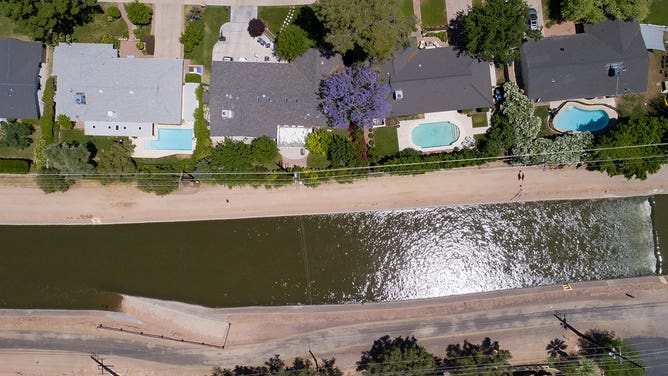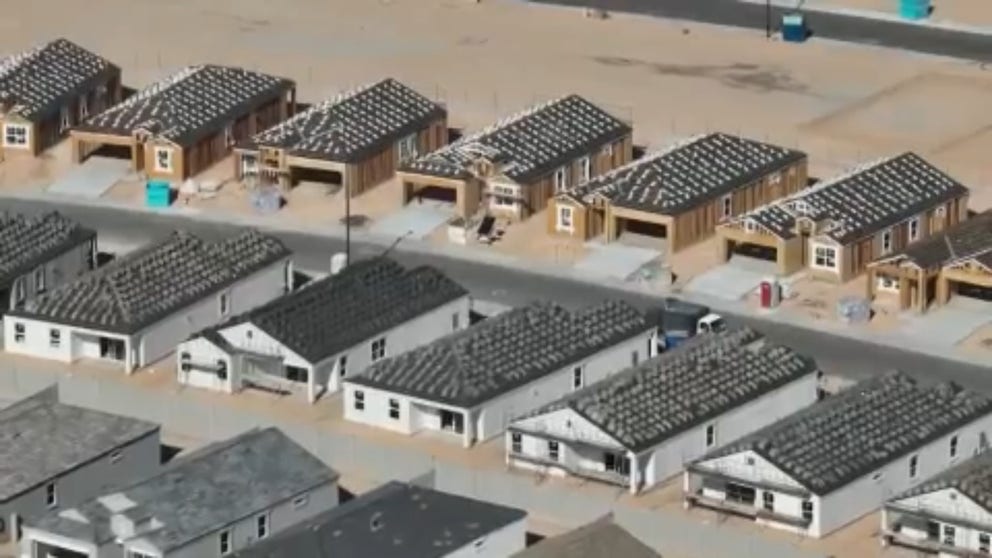Dwindling water supply prompts limits on new Phoenix-area construction
Despite the move, Arizona Gov. Katie Hobbs said the state isn’t running out of water. "Nobody who has water is going to lose their water," Hobbs said.
New Phoenix-area development projects paused because of dwindling water supply
Gov. Katie Hobbs is putting a pause on new development projects because of a dwindling water supply in our state. But will it impact construction that's already underway? FOX 10's Lindsey Ragas has the details.
PHOENIX - Arizona Gov. Katie Hobbs announced construction around Phoenix will be limited moving forward to protect groundwater supplies. This comes after Arizona was one of three southwestern states to reach a historic agreement to cut millions of gallons of Colorado River water usage over the next four years.
The governor said the restriction will only impact new development, not current development.
"For generations, groundwater has supported Arizona communities," Hobbs said. "In times of shortage, it is groundwater that we turn to as a backup. In many communities throughout Arizona, it is the only water supply available, and so we must manage it wisely."
Driving the state's decision was a projection that showed that over the next 100 years, demand in metro Phoenix for almost 4.9 million acre-feet of groundwater would be unmet without further action, Hobbs said. An acre-foot of water is roughly enough for two to three U.S. households per year.
Despite the move, the governor said the state isn’t running out of water. "Nobody who has water is going to lose their water," Hobbs said.
Officials said the move would not affect existing homeowners who already have assured water supplies.
Hobbs released a study analyzing groundwater supplies in the Phoenix area for the next century. She says it allows certainty for businesses and communities.
"If we do nothing, we could face a 4% shortfall in groundwater supplies over the next 100 years," Hobbs said. "We have to close this gap and find efficiencies for our water use, manage our aquifers wisely and increase our utilization of renewable supplies."
Closing that gap includes pausing water supply certificates.
ARIZONA FAMILY SENDS WARNING AFTER TODDLER SUFFERS SECOND-DEGREE BURNS ON FEET FROM HOT CONCRETE

The Central Arizona Project carries Colorado River water on October 25, 2022 outside suburbs in Phoenix, Arizona. The flight for aerial photography was provided by LightHawk. (Photo by RJ Sangosti/MediaNews Group/The Denver Post via Getty Images)
(Getty Images)
"Everywhere in the Phoenix AMA (active management areas) where a new development or certificate is sought, we will not be able to approve that certificate based solely on groundwater," said Arizona Department of Water Resources Director Tom Buschatzke. "There are other ways they can meet certificate requirements. They can bring in not groundwater resources outside AMAs. They can utilize long-term storage credits that are already underground for these purposes. They can use unreclaimed water."
Hobbs said there is a bipartisan solution moving forward through legislation to address underlying issues, like the Rio Verde water situation.
"That's an example of a development that happened using loopholes in the groundwater management program, and that's why the groundwater management program is important," Hobbs said.
Hobbs also announced a $40 million investment of American Rescue Plan Act funds for water conservation, infrastructure and sustainable groundwater management.
"This Phoenix AMA groundwater model and 100-year forecast are critical tools that help us look into the future and proactively manage our water supplies," Hobbs said.
THE US DROUGHT MONITOR EXPLAINED
As for the certificates, Hobbs said this will not impact the 80,000 unbuilt homes that already have certificates. There are pending applications in the Buckeye area.
Years of drought in the West worsened by climate change have ratcheted up pressure among Western states to use less water. Much of the focus has stayed on the dwindling Colorado River, a main water source for Arizona and six other Western states. Over the past two years, Arizona's supply from the 1,450-mile powerhouse of the West has been cut twice.
Phoenix relies on imported Colorado River water and also uses water from the in-state Salt and Verde rivers. A small amount of the city’s water supply comes from groundwater and recycled wastewater.
The drought has made groundwater — held in underground aquifers that can take many years to be replenished — even more vital.
Under a 1980 state law aimed at protecting the state’s aquifers, Phoenix, Tucson and other Arizona cities have restrictions on how much groundwater they can pump. In rural areas, there are few limitations on its use.
SCOTTSDALE, ARIZONA, CUTS OFF WATER TO SUBURB IN RESPONSE TO COLORADO RIVER DROUGHT

A section of the Central Arizona Project, a series of aqueducts and tunnels designed to bring water from the Colorado River to central and southern Arizona, flows past single family homes with swimming pools in Phoenix, Arizona, on May 9, 2023.
(Rebecca Noble/Bloomberg / Getty Images)
Long pumped by farmers and rural residents in Arizona with little oversight, Hobbs and other state officials recently vowed to take more steps to protect the state's groundwater supplies.
In rapidly growing Phoenix suburbs such as Queen Creek and Buckeye, developers have relied on unallocated groundwater to show that they had adequate water supplies for the next 100 years, which Arizona requires for building permits in some areas.
"Developers rely on groundwater because it has been frankly, cheaper and easier for them, and they have been able to move through the process much more quickly," said Nicole Klobas, chief counsel for the Arizona Department of Water Resources.
7 WAYS TO CONSERVE WATER AT HOME DURING A DROUGHT
Under the new restrictions, that won't be possible.
"It closes off that path," said Kathryn Sorenson, director of research at the Kyl Center for Water Policy at Arizona State University.
Because the rule largely affects cities and towns outside Phoenix and larger cities in the metro area, Sorenson said developers would likely "weigh whether they want to continue to buy relatively cheap land ... and incur the cost of developing a whole new water supply versus purchase land that is probably more expensive without the boundaries of a designated city."
The Associated Press contributed to this report.
